Circadian Rythms & Sleep
1/75
There's no tags or description
Looks like no tags are added yet.
Name | Mastery | Learn | Test | Matching | Spaced |
|---|
No study sessions yet.
76 Terms
What are the Biological Rhythms?
Endogenous
Exogenous
Endogenous
Biological clocks (i.e., that are internal to the individual) influence biological rhythms
Endogenous Circannual Rhythm
Their brain is keeping track of the date to generate
Endogenous means “generated from within”
Circannual comes from the Latin words circum, for “about,” and annum, for “year”
Endogenous Circadian Rhythms
Animals produce endogenous circadian rhythms that last about a day. (Circadian comes from the Latin cir- cum, for “about,” and dies, for “day.”)
Exogenous
changes in the environment (i.e, those that are external to the individual) influence biological rhythms
Circadian Rhythms
Cycles that unfold over roughly a 24-hr period
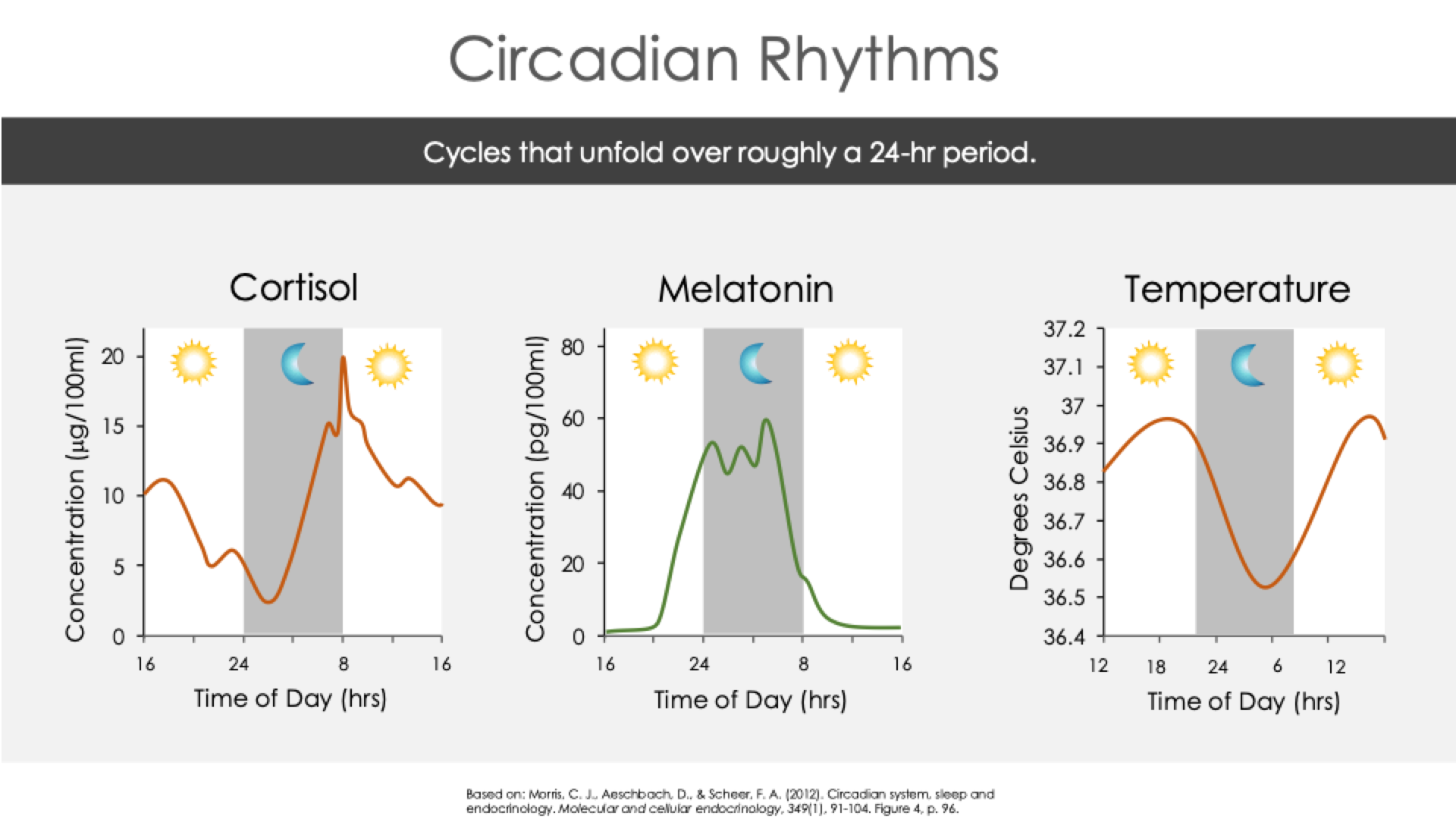
Chronotypes
People differ regarding when they feel most energetic and least sleepy
Early Chronotype
People wake up early and do better throughout the day
Late Chronotype
They prefer to wake up late
Perform better later in the day
How does moving school timings align with adolescent sleep and chronotype patterns?
“… moving school start times later so that they are better aligned with adolescent sleep and chronotype patterns is practical and beneficial. Following a change to a 10:00am school start time (from an 8:50am start time), rates of absence due to illness in students aged 13-16 reduced, and academic performance of students aged 14-16 significantly improved.”
Free Running Rhythms and Zeitgebers
Zeitgebers include light, exercise, mealtimes, temperature
Means time-giver in German
Natural light Exposure
Free Running
What is the stimulus that resets your circadian rhythm?
Zeitegeiber
What Happens to Blind People and Free-running Rhythms?
In blind people who have free-running rhythms, periodic symptoms of insomnia and daytime sleepiness commonly occur when the circadian pacemaker and, therefore, the circadian rhythm of sleepiness drift out of phase with the desired time for sleeping. These symptoms vary considerably but can be among the most burdensome aspects of blindness
Jet Lag
A disruption of circadian rhythms after crossing time zones is known as jet lag

Fill in the Blank: What eastward travel the circadian system has to _________ _________
Phase advance
Fill in the Blank: What westward travel the circadian system has to _________ _________
Phase delay
Adjusting to Jet Lag is Stressful
Stress elevates blood levels of the adrenal hormone cortisol, and prolonged elevation of cortisol damages neurons in the hippocampus, an area important for memory.
The Suprachiasmatic Nucleus (SCN)
The main driver of rhythms for sleep and body temperature is the suprachiasmatic nucleus or SCN, a part of the hypothalamus
The SCN generates circadian rhythms automatically
True or False: The SCN controls circadian rhythms (CRs) and depends on other structures to maintain CRs
False
The SCN controls circadian rhythms (CRs) and it does NOT depend on other structures to maintain CRs
What happens if neurons are disconnected from the rest of the brain or removed from the body and maintained in tissue culture?
SCN neurons continue to produce a circadian rhythm of action potentials
True or False: A single SCN cell can maintain a circadian rhythm, but not very accurately
True
Interactions among neurons and astrocytes sharpen the accuracy of the rhythm
SCN and Hamsters Experiment
A mutation in one gene causes hamsters’ SCN to produce a 20-hour instead of 24-hour rhythm
Researchers surgically removed the SCN from adult hamsters and transplanted SCN tissue from hamster fetuses into the adults
When they transplanted SCN tissue from fetuses with a 20-hour rhythm, the recipients produced a 20-hour rhythm.
When they transplanted tissue from fetuses with a 24-hour rhythm, the recipients produced a 24-hour rhythm
That is, the rhythm followed the pace of the donors, not the recipients. In short, the rhythms come from the SCN itself.
What alter’s the SCN’s setings
A small branch of the optic nerve, the retinohypothalamic path from the retina to the SCN, alters the SCN’s settings.
Most of the input to that path does not come from normal retinal receptors.
Blind Mole Rats and Circadian Rhythms
They are evolutionarily adapted to spend most of their lives underground. They have fewer than 900 optic nerve axons, compared with 100,000 in hamsters. Even a bright flash of light evokes no startle response and no measurable change in brain activity. Nevertheless, light resets their circadian rhythms, enabling them to be awake only at night
What is the reason light resets their circadian rhythms, enabling blind mole rates to be awake only at night?
The reason is that the retinohypothalamic path to the SCN comes from certain retinal ganglion cells with their own photopigment, melanopsin. These special ganglion cells receive some input from rods and cones, but even without that input, they respond directly to light. They are located mainly near the nose, and therefore see toward the periphery.
Intrinsically Photosensitive Retinal Ganglion Cells
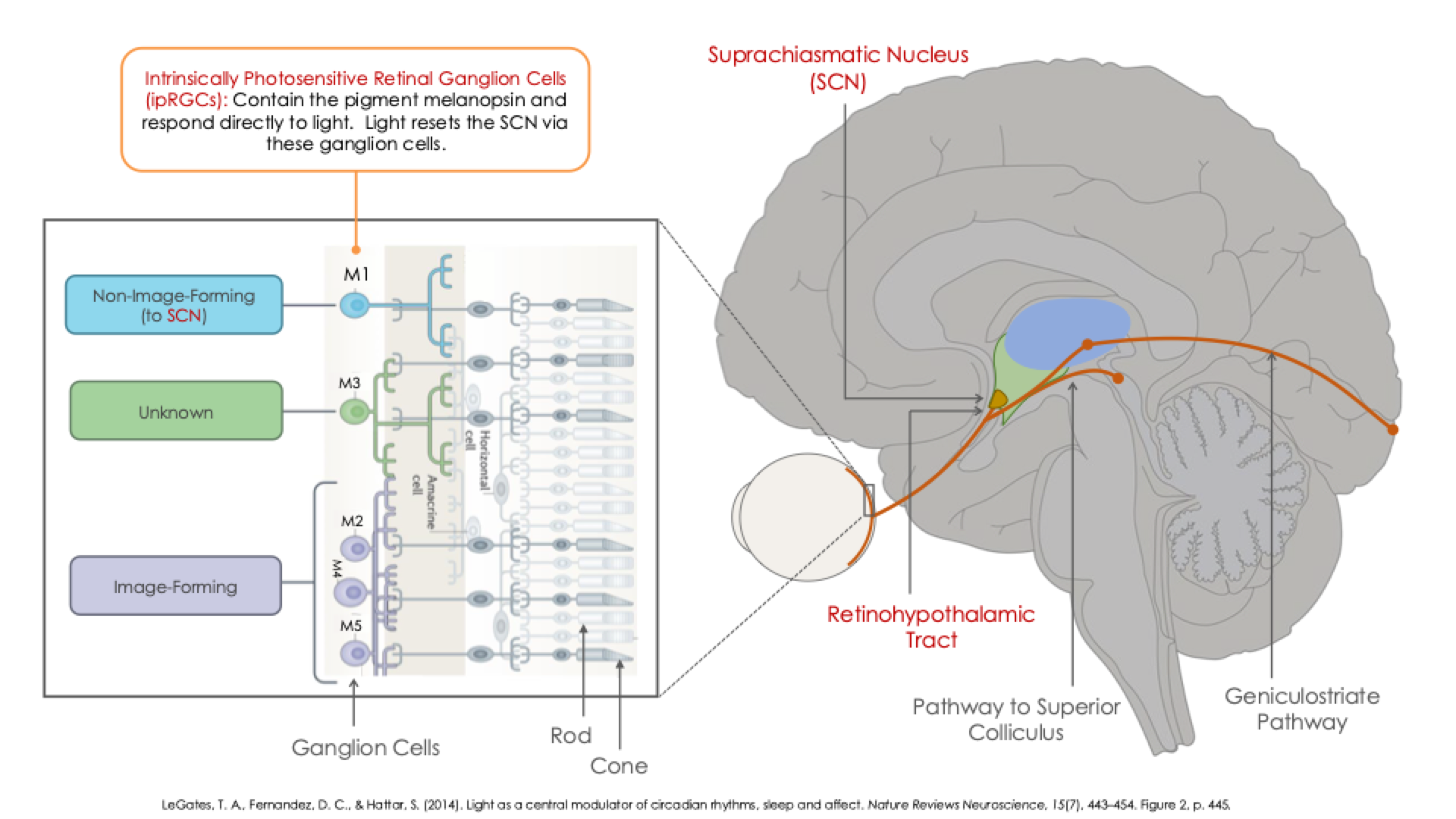
Contain the pigment melanospin and respond directly to light. Light resets the SCN via these ganglion cells
They don’t need rods and cones they’re light activated
What proteins concentration promote sleep, oscillates over a day, based on feedback interactions? (2 Proteins)
PER and TIM
Period, which produces the protein PER
Timeless, which produces the protein TIM
Biochemistry of the Circadian Rhythm
Early in the morning, the messenger RNA levels responsible for producing PER and TIM start at low concentrations.
As they increase during the day, they slowly increase synthesis of the proteins
As the PER and TIM pro- tein concentrations increase, they feed back to inhibit the genes that produce the RNA molecules.
During the night, the PER and TIM concentrations remain high, promoting sleep, but the messenger RNA concentrations are declining
Light triggers a breakdown of TIM. By the next morning, PER and TIM protein levels have declined, the fly awakens, and the cycle is ready to start again.

The suprachiasmatic nucleus regulates waking and sleeping by controlling activity levels in other brain areas, including ___________?
the pineal gland, and endocrine gland located just posterior to the thalamus
What hormone does the pineal gland release?
Melatonin
Melatonin
a widespread chemical found in nearly all animals - sponges are the only known exception - as well as in plants and bacteria
In diurnal animals like humans in increases sleepiness
In addition to regulating sleep and wake- fulness, melatonin also helps control the onset of puberty and adjustments to changes of season, such as hibernation.
What parts of the brain does melatonin have a feedback effect on?
Melatonin enters the bloodstream and has a feedback effect on the SNC through MT1 and MT2 receptors
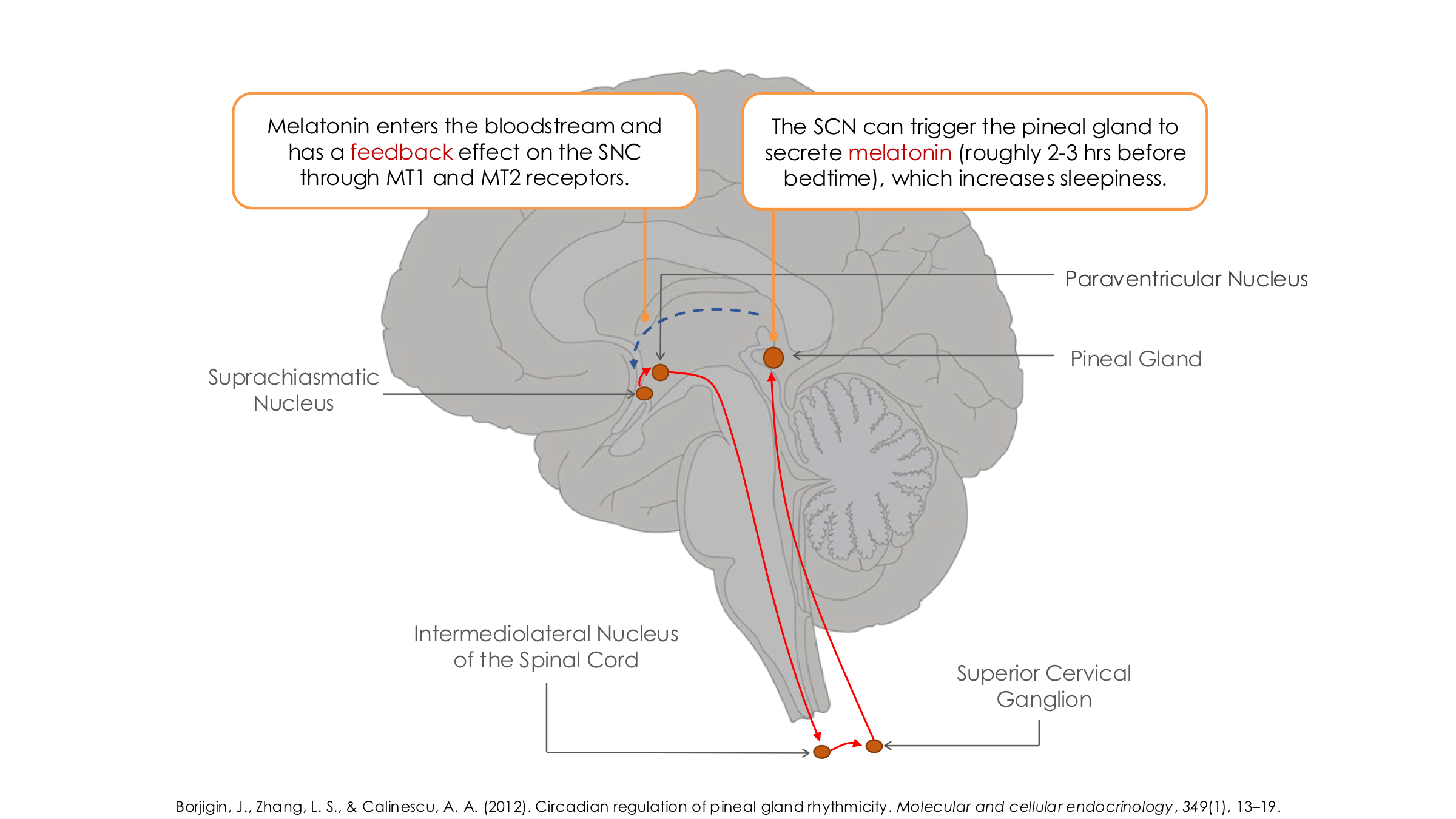
When and how does melatonin start secretion?
The SCN can trigger the pineal gland to secrete melatonin (roughly 2-3 hrs before bedtime), which increases sleepiness
True or False: Taking melatonin in the evening has little effect on sleepiness
True
Taking a melatonin pill in the evening has little effect on sleepiness because the pineal gland produces melatonin at that time anyway. Taking melatonin earlier can hasten the onset of sleepiness and shift the circadian rhythm. Melatonin pills are sometimes helpful when people travel across time zones and need to sleep at an unaccustomed time.
Sleep
Sleep is a state that the brain actively produces, characterized by decreased activity and decreased response to stimuli.
Coma
an extended period of unconsciousness caused by head trauma, stroke, or diseases
Someone in a coma has a low level of brain activity and no response to stimuli, not even to a strong pinch or a loud noise.
Most people in a coma either die or begin to recover within a few weeks.
Unresponsive Wakefulness Syndrome
Someone in this condition alternates between sleep and moderate arousal, but even during the more aroused state, the person shows no awareness of surroundings and no purposeful behavior.
Breathing is more regular, and a painful stimulus increases heart rate, breathing, and sweating
Eye movements occur, but they do not follow a target
The person might laugh or cry, but not in response to an external event
This is a step up from coma
Minimally Conscious State
Brief periods of purposeful actions and a limited amount of speech comprehension.
A minimally conscious state can last for months or years
Higher stage than unresponsive wakefulness syndrome
Brain Death
a condition with no sign of brain activity and no response to any stimulus.
Physicians usually wait until someone has exhibited no sign of brain activity for 24 hours before pronouncing brain death, at which point most people believe it is ethical to remove life support.
Diagram: Sleeping Organisms working Together
All these work together to keep us aroused/active.
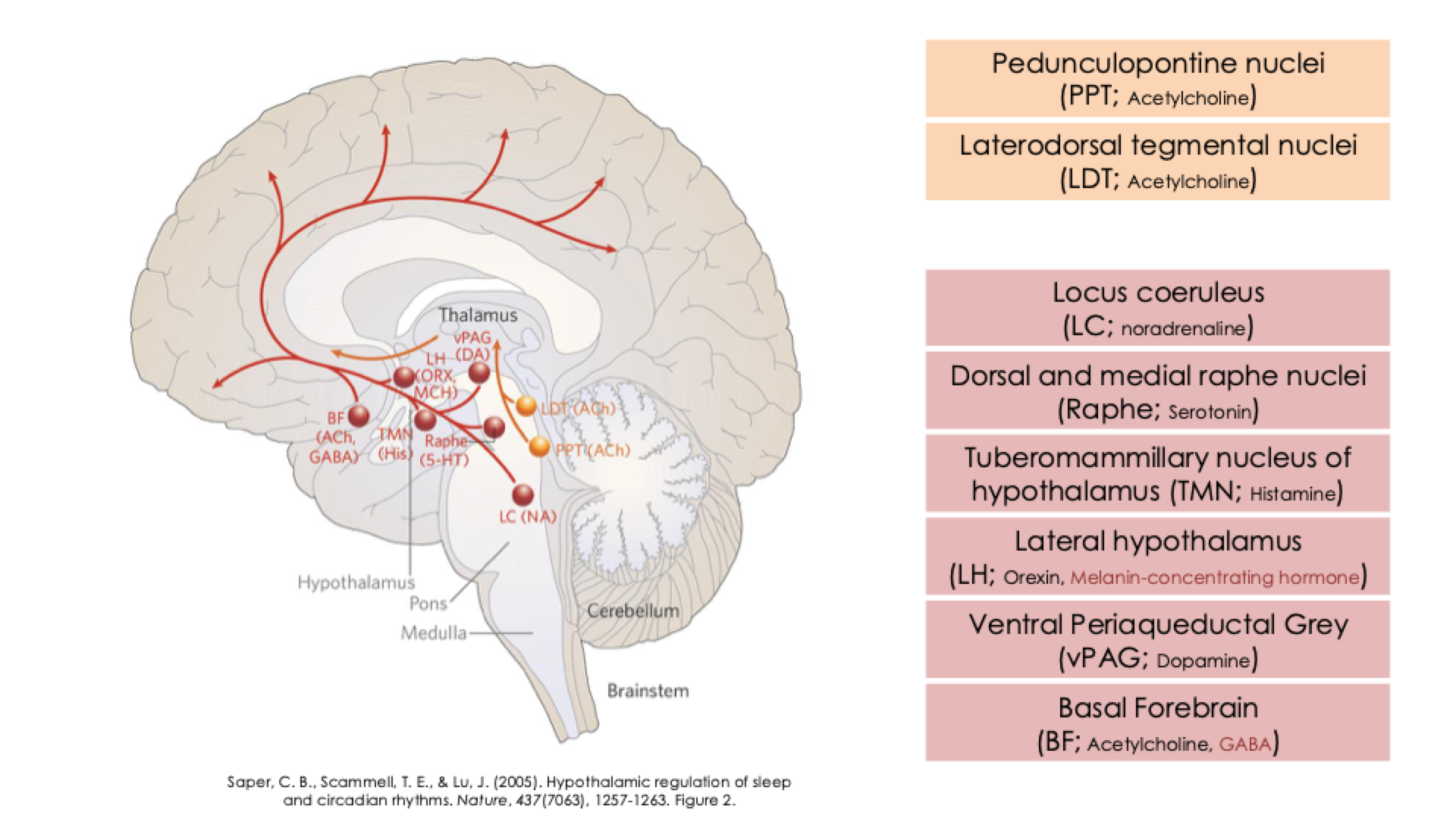
The Ventrolateral Pre-optic Nucleus (VLPO)
The VLPO neurons are primarily active during sleep, and contain the inhibitory neurotransmitters, galanin and GABA
Active VLP inhibits the areas responsible for wakefulness
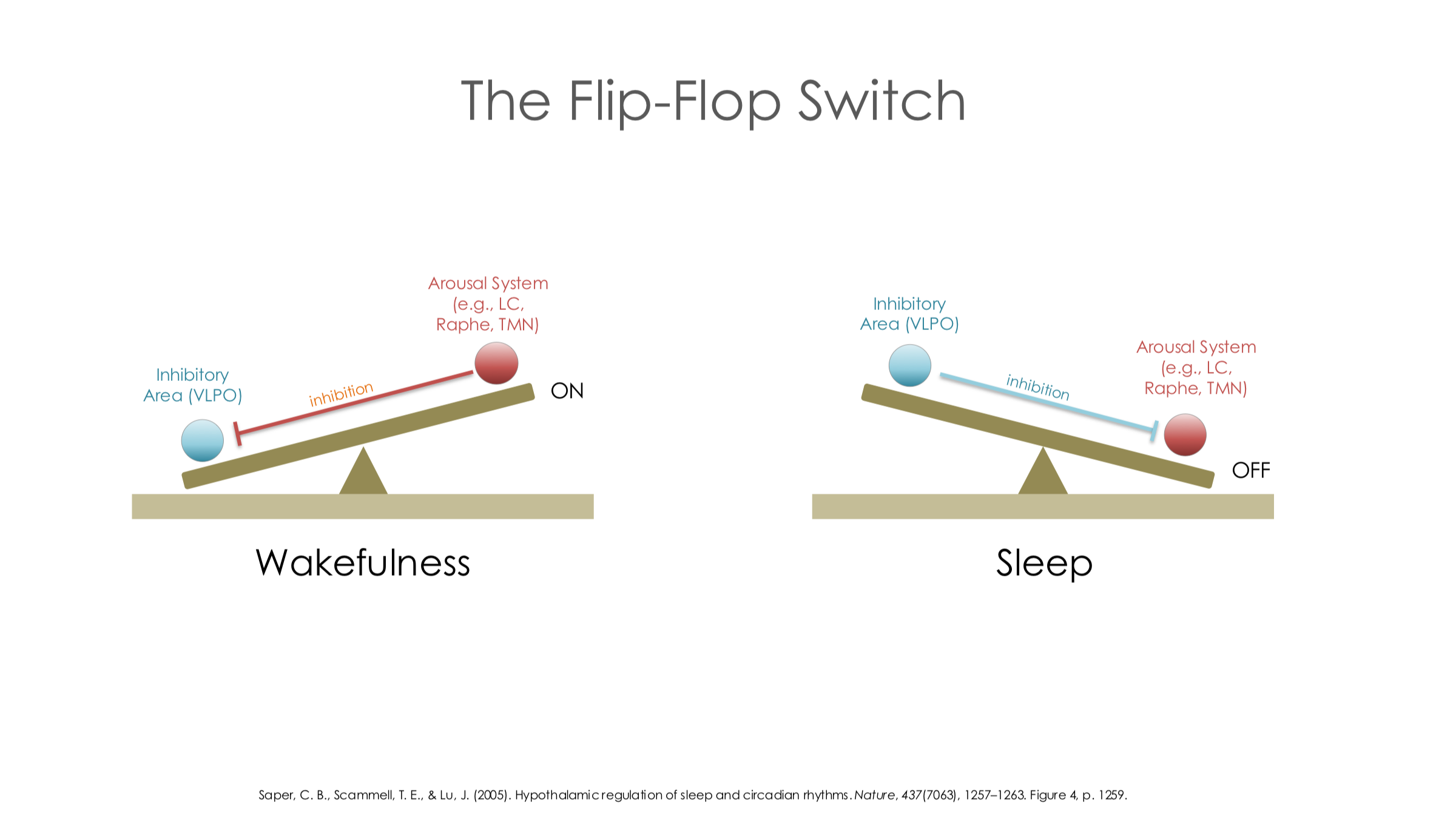
The Flip-Flop Switch
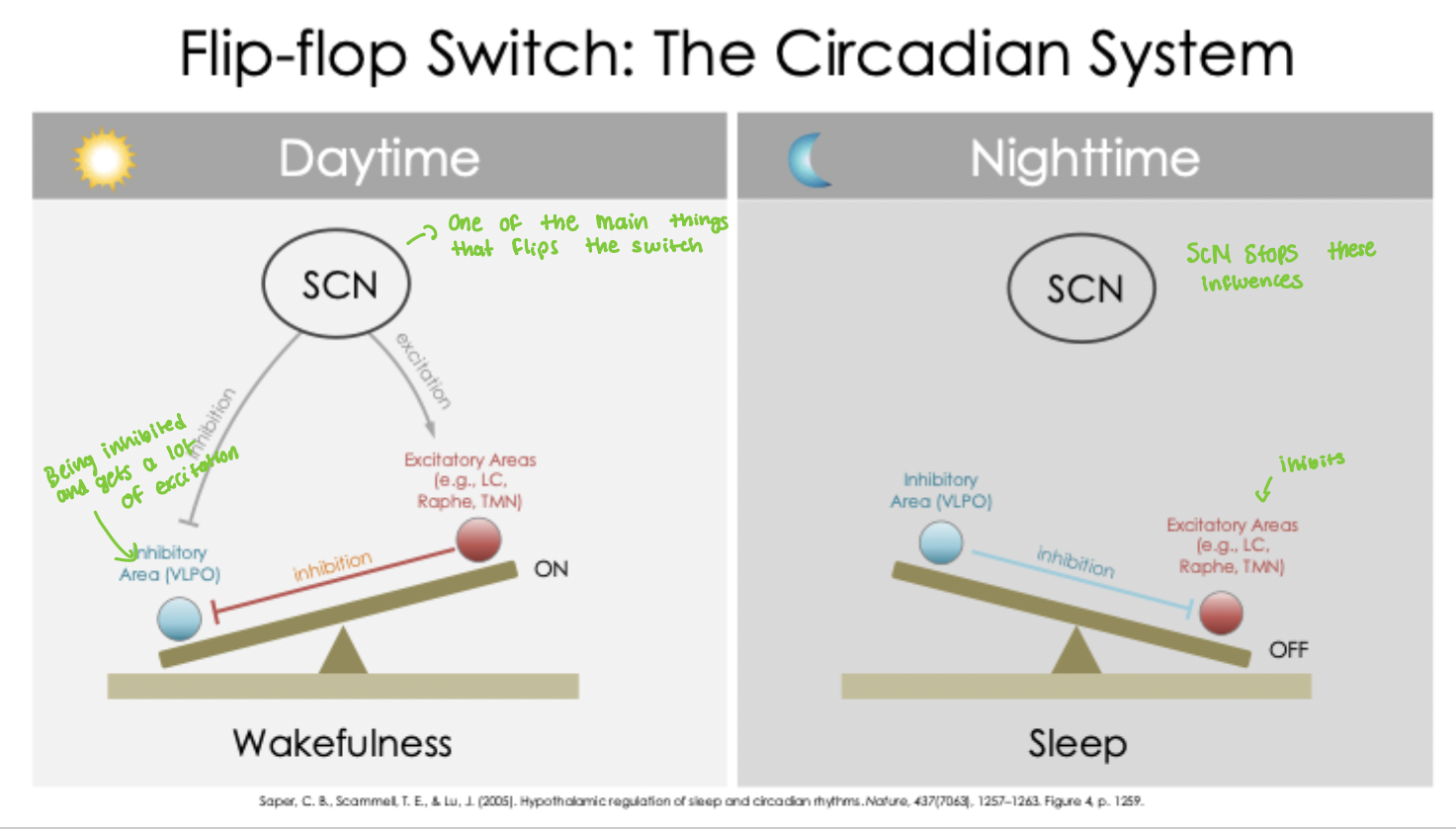
Flip-Flop Switch: Sleep Pressure
Builds up sleep CATP at the peak
Adenosine build up helps sleep
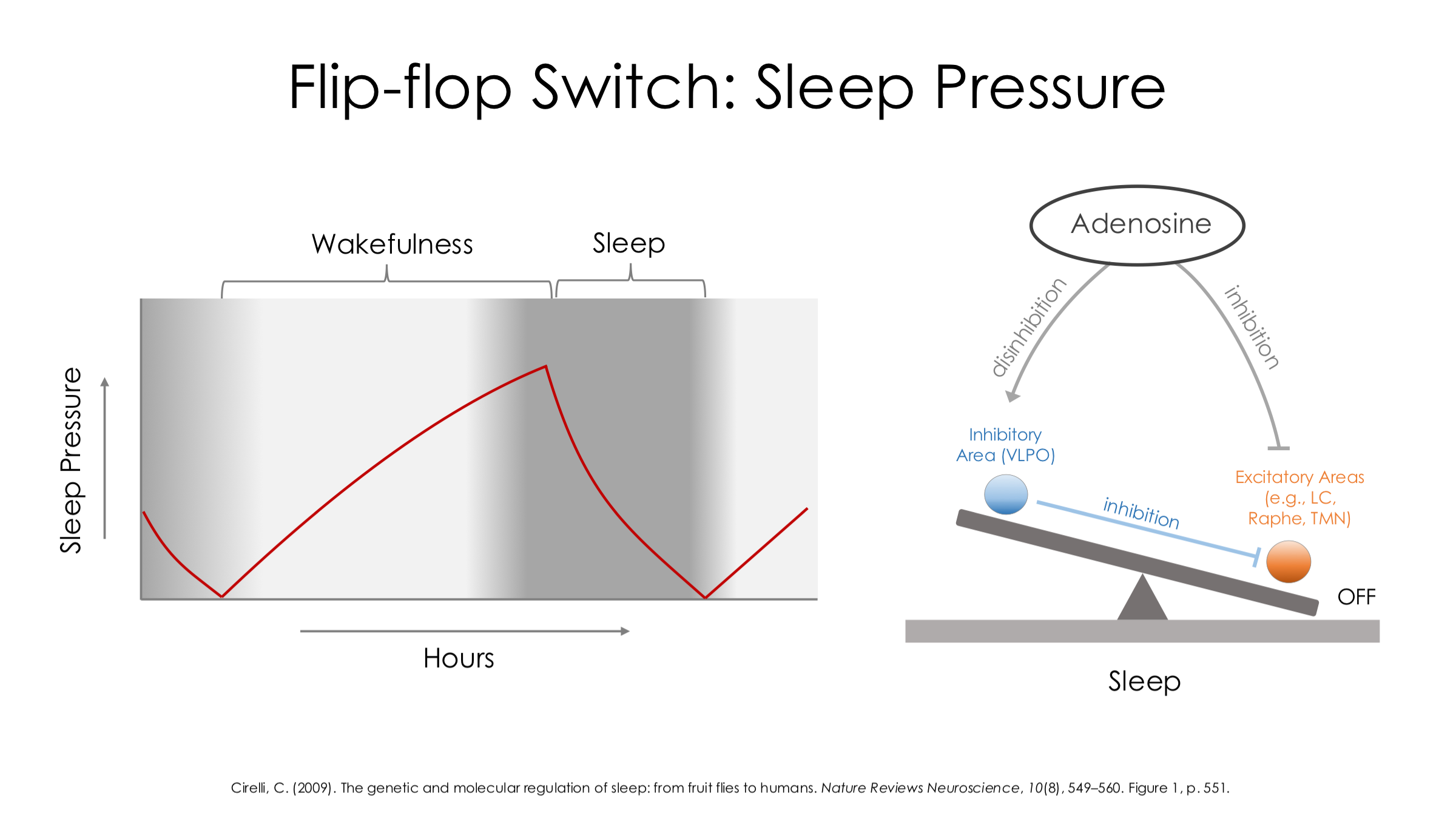
Stages of Sleep: Polysomnograph
A combination of EEG and eye-movement records
Alpha waves are a characteristic of relaxation
At a frequency of 8-12 seconds
Stage 1: Sleep has just begun
The EEG is dominated by irregular, jagged, low-voltage waves
Brain activity is less than in relaxed wakefulness but higher than in other sleep stages
Most neurons are out of phase with one another, the EEG is full of short, rapid, choppy waves
Stage 2: K-complexes and Sleep Spindles
Sleep Spindles: a burst of 12-14 Hz waves for at least half a second
K-complex: a sharp high-amplitude negative wave followed by a smaller, slower positive wave
Thought to be a related to memory
Stages 3 and 4 = Slow Wave Sleep (SWS)
EEG recording of slow, large amplitude wave
Slowing of HR, breathing rate, & brain activity
Highly synchronized neuronal activity
REM Sleep or Paradoxical Sleep
Paradoxical sleep it is deep sleep in some ways and light in others.
Periods of rapid eye movement sleep (REM); aka paradoxical sleep
EEG waves are irregular, low-voltage & fast, indicating ↑ neuronal activity (light sleep)
Postural muscles of the body are more relaxed than in other stages (deep sleep)
Increases neural activity
Researchers mostly use the term REM sleep, but they often prefer the term paradoxical sleep for species that lack eye movements.
Rapid Eye Movement (REM) Sleep
Only after repeated careful measurements did they conclude that periods of eye movements occur during sleep
What are the other stages other than REM
non-REM (NREM) sleep
Sleep Cycles: Hypnogram
Represents the time spent in the various stages of sleep during a single night

Young Adult and Older Adult
Older adults show more waking moments
Older adults experience less REM sleep
Older adults have less deep sleep
Function of Sleep: Restoration
Growth hormone: Peaks at midnight and drops
Cell Replication: Peaks at midnight
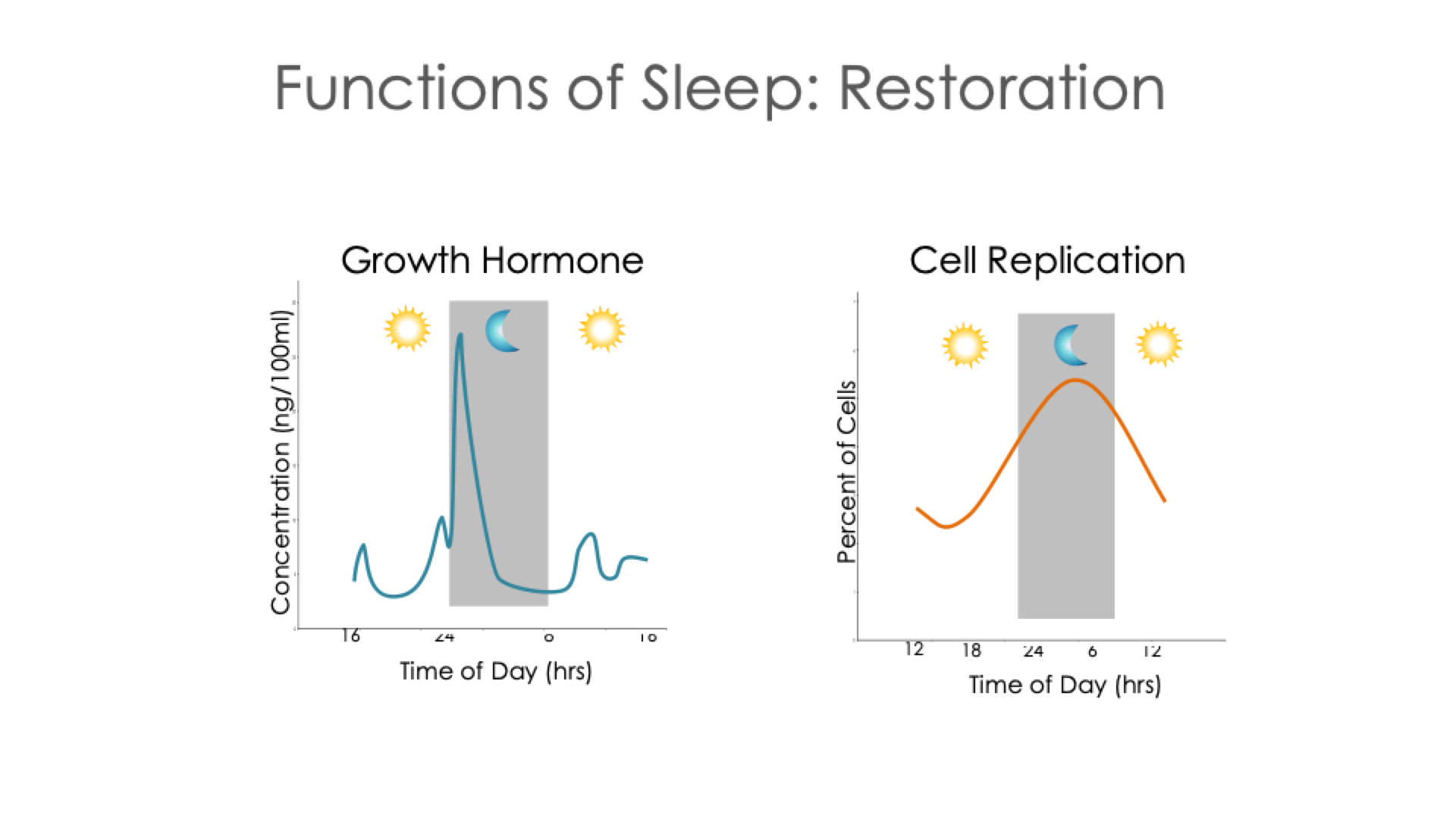
Functions of Sleep: Clearance
Movement of subtances through the interistital space was more efficient while the rat was asleep than when it was awake
Rate of b-amyloid clearance was greater during sleep than during wakefulness
Functions of Sleep: Memory
Sleep is important for certain tasks like memory consolidation
True or False: A cut through the midbrain decreases arousal by damaging the reticular formation, a structure that extends from the medulla into the forebrain.
True
Some neurons of the reticular formation have axons ascending into the brain, and some have axons descending into the spinal cord. Those with axons descending into the spinal cord form part of the corticomedial tract of motor control.
What contributes to cortical arousal?
Pontomesencephalon (The term de-rives from pons and mesencephalon, or “midbrain.”)
These neurons receive input from many sensory systems and also generate spontaneous activity, varying with the circadian rhythm. Their axons extend into the forebrain
True or False: The locus coeruleus, a small structure in the pons, is usually inactive, especially during sleep, but it emits bursts of impulses in response to meaningful, memorable events, especially those that produce autonomic arousal or stress
True
Axons from the locus coeruleus release norepinephrine widely throughout the cortex, so this tiny area has a huge influence.
Another pathway of the hypothalamus release what transmitters?
Orexin and Hypocretin
Orexin is important for staying awake.
What does the basal forebrain do?
Other pathways from the lateral hypothalamus regulate cells in the basal forebrain. Basal forebrain cells provide axons that extend throughout the thalamus and cerebral cortex, some of them increasing wakefulness and others inhibiting it. Acetylcholine stimulates the basal forebrain cells that promote wakefulness
REM sleep is associated with a distinctive pattern of high-amplitude electrical potentials known as what?
PGO waves, for pons-geniculate-occipital
Dreaming: The Activation Synthesis Model

Lucid Dreaming
During Lucid dreaming, someone is dreaming but aware of being asleep and dreaming.
Enough activity occurs in the frontal and temporal cortex to enable conscious monitoring of the dreams that the rest of the brain is generating
Someone having a lucid dream can control the content of the dream to some extent, as well as eye movements.
When people had lucid dreams about moving their hands, activity increased in the areas of the motor cortex responsible for preparing for a hand movement, but not in the primary motor cortex that would have produced actual movements
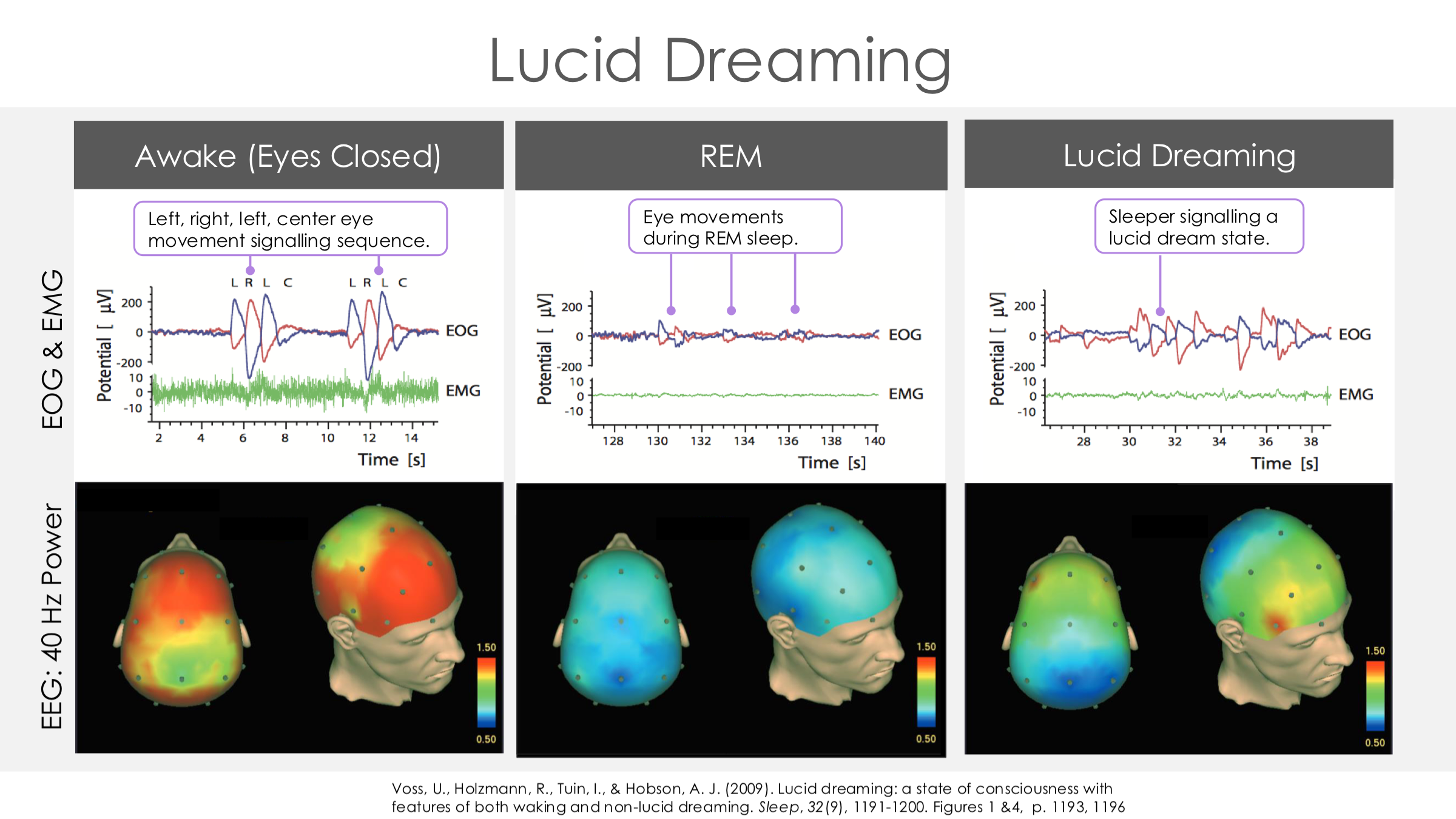
Insomnia Causes
Inadequate sleep
noise, uncomfortable temperatures, stress, pain, diet, and medications
Sometimes it can be a result of epilepsy, Parkinson’s disease, brain tumours, depression, anxiety or other neurological or psychiatric conditions
Some cases could be because of shifts in circadian rhythms
Example: Someone whose rhythm is phase delayed has trouble falling asleep at the usual time, as if the hypothalamus thinks it isn’t late enough. Someone whose rhythm is phase advanced, as in falls asleep easily but awakens early.
Another cause of insomnia is, paradoxically, the use of sleeping pills. Frequent use causes dependence and an inability to sleep without the pills
Example: For most people, drinking coffee during the evening interferes with sleep. Coffee also phase-delays the circadian rhythm, delaying the release of melatonin
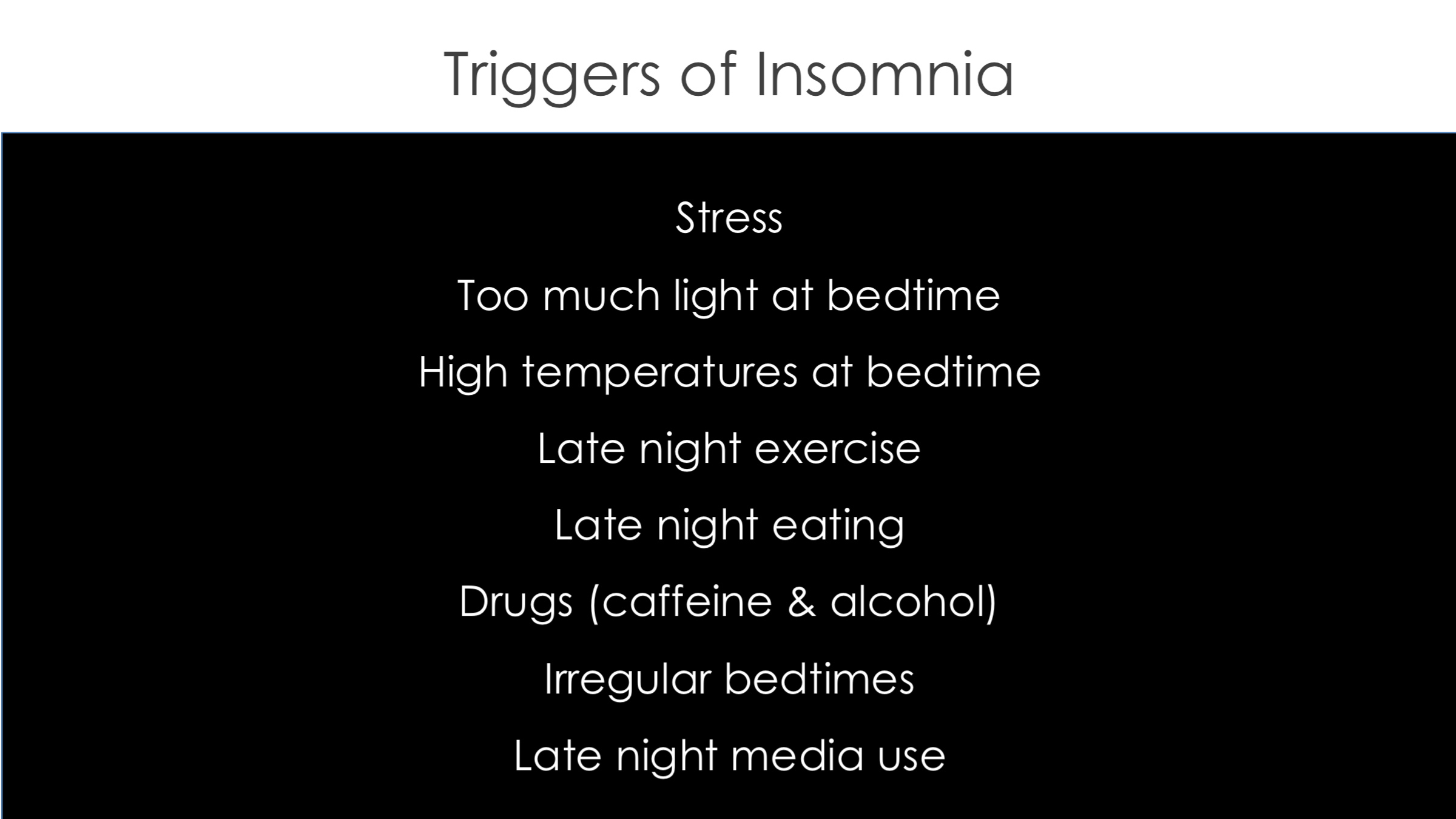
Sleep Apnea or Obstructive Sleep Apnea Syndrome (OSAS)
OSAS is characterized by recurrent pharyngeal collapses during sleep
People with sleep apnea have breathless periods of a minute or so from which they awaken gasping for breath.
Prolonged sleep apnea leads to a loss of neurons, with an impairment of learning and other functions
Sleep apnea is often related to obesity, especially in middle-aged men.
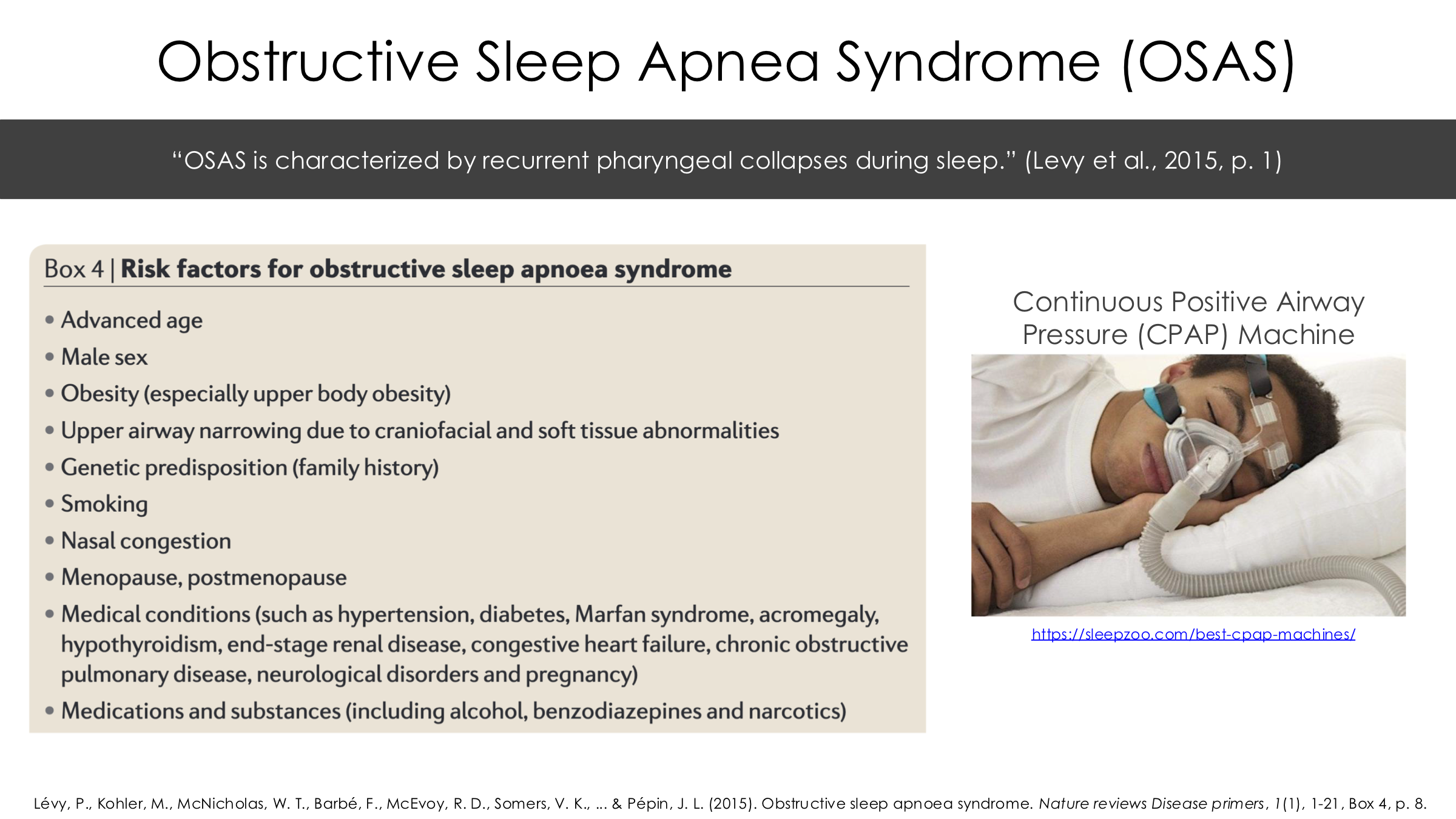
Narcolepsy
A condition characterized by periods of sudden sleepiness during the day affects about 1 person in 1,000.
It sometimes runs in families, but most cases emerge in people with no affected relatives.
A loss of orexin producing neurons in the lateral hypothalamus, which normally activate other areas promoting wakefulness
What are the 4 main symptoms of Narcolepsy
Sleep Attacks
Cataplexy (Occasional)
Sleep Paralysis
Hallucinations
Sleep Attacks
Unexpected sleepiness during normal waking hours
Cataplexy (Occasional)
Unexpected moments of muscle weakness while the person is awake.
Cataplexy is often triggered by strong emotions, such as anger or great excitement
Example: One man suddenly collapsed during his wedding ceremony. The amygdala, important for emotional processing, is active at the start of a REM period and at a narcoleptic attack
Sleep paralysis
an inability to move while falling asleep or waking up
Many people have experienced sleep paralysis occasionally, but people with narcolepsy experience it frequently
Hallucinations
Hypnagogic (while falling asleep): dreamlike experiences that the person has trouble distinguishing from reality, often at the onset of sleep.
Hypnopompic:
Parasomnia’s Diagram

REM behaviour disorder
a condition in which people move around vigorously during REM sleep
Night terror - when does it occur?
an experience of intense anxiety from which a person awakens screaming in terror
more severe than nightmare
occurs during NREM sleep and are more common in children than adults
When is sleepwalking most common?
slow-wave sleep or early in the night
does not occur in REM because large muscles are completely relaxes
Sexomnia
Masturbating or having sex with people in your sleep without remembering